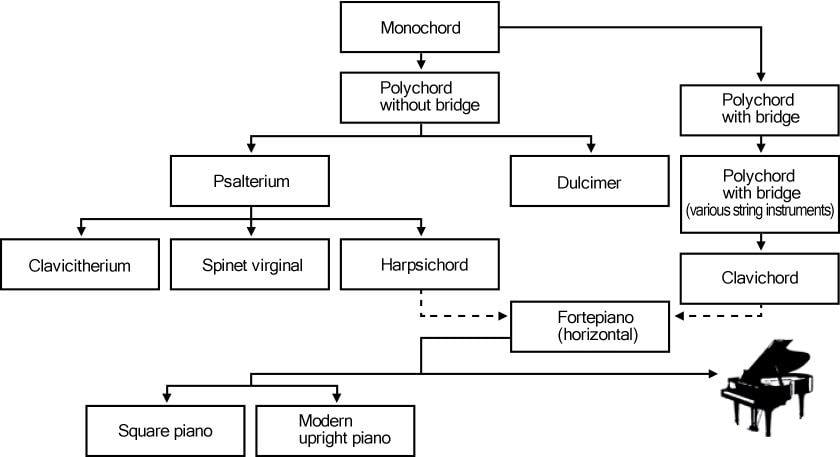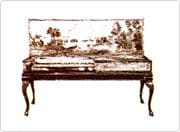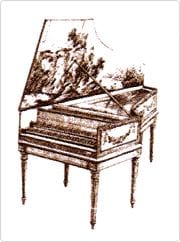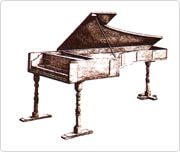The Story of the Piano's Invention
The Piano's Ancestor was a Monochord Instrument
Instruments can be divided into three categories based on how they produce sounds. Those categories are string instruments, wind instruments, and percussion instruments. The piano's ancestry can be traced back through various instruments such as the clavichord, harpsichord, and dulcimer. But if it were traced back even further, one would find that the piano is a descendant of the monochord. In other words, based on its ancestry the piano can be classified as a string instrument.
Origins of the piano

The Piano Has the Same Mechanism as the Dulcimer

Although the piano can be classified as a string instrument due to the fact that the sounds come from the vibration of strings, it can also be classified as a percussion instrument because a hammer strikes those strings. In this way it is similar to a dulcimer.
The dulcimer is an instrument that originated in the Middle East and spread to Europe in the 11th century. It features a simple resonating box with strings stretched on top of it. Much like a piano, a small hammer is used to hit the strings, which is why the dulcimer is considered to be a direct ancestor of the piano.
The Clavichord, a Big Step Towards the Piano

The piano is also considered to be a part of the keyboard family. The history of instruments with keyboards dates far back and originates from the organ, which sends bursts of air through pipes to make sound. Craftsmen improved upon the organ to develop an instrument that was a step closer to the piano, the clavichord.
The clavichord first appeared in the 14th century and became popular during the Renaissance Era. Pressing a key would send a brass rod, called a tangent, to strike the string and cause vibrations that emit sound over a range of four to five octaves.
The Piano Looks Like a Harpsichord

Created in Italy in around 1500, the harpsichord later spread to France, Germany, Flanders, and Great Britain. When a key is pressed, a plectrum attached to a long strip of wood called a jack plucks the string to make music.
This system of strings and soundboard, and the overall structure of the instrument resemble those that can be found in a piano.
Cristofori, Creator of the First Piano
The piano was invented by Bartolomeo Cristofori (1655-1731) of Italy.
Cristofori was unsatisfied by the lack of control that musicians had over the volume level of the harpsichord. He is credited for switching out the plucking mechanism with a hammer to create the modern piano in the year 1709.
The instrument was actually first named "clavicembalo col piano e forte" (literally, a harpsichord that can play soft and loud noises). This was shortened to the now common name, "piano."


Musical Instrument Guide : Piano Contents
Origins
Structure
How to Play
How the Instrument is Made
Choosing an Instrument
Care and Maintenance
Trivia
- The White Keys and Black Keys Were Reversed on Pianos in Mozart's Day
- Did Mozart's Piano Have a Pedal-Board?
- Piano with Automatic Accompaniment System in Beethoven's Day
- The Pianos Beloved by the Great Master, Sviatoslav Richter
- The Optimal Material for Piano Frames Is Also Ideal for Motorcycle Engines
- The Piano Soundboard Is a Board that Also Stops Vibrations
- Why Can't There Be More Than 88 Keys on a Piano?
- Why a Grand Piano Keyboard Feels Heavier Than an Upright Keyboard?
